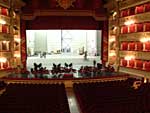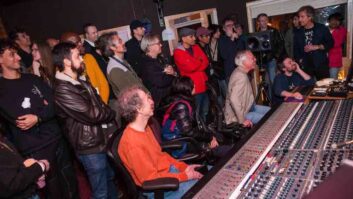
The recently restored La Scala stage
Italy’s national broadcaster, RAI, has opened an all-digital recording facility inside one of Milan’s opera house, Teatro alla Scala. RAI is recording and broadcasting key opera and orchestral performances from this location using a Studer Vista 8 digital audio production console supplied by Analog & Digital Technology (A&DT) srl.
One of Milan’s most prominent cultural landmarks, La Scala closed its doors for over two years to restore its classic interior and completely overhaul the technical layout of the theatre, more than doubling the size of the stage and backstage production areas, and installing sophisticated hydraulics. During the renovation, with the artistic activity of the resident companies relocated to the Teatro degli Arcimboldi, RAI’s technical project engineers took the opportunity to construct a first-class recording studio.
RAI has been broadcasting performances live from La Scala for more than 20 years, but its production facilities have been cramped and imperfect. The new digital studio, which features a 60-fader Studer Vista 8 audio console, has been designed by consultant Lucio Visintini for the radio division of RAI. Aside from recording six opera productions and approximately 16 orchestral concerts for broadcast each year, the studio will record selected productions onto multi-track. After post-production at RAI’s facilities in Milan, these will be issued on DVD as commercial releases.
La Bohème, with art direction by Franco Zeffirelli, is the first opera production to be broadcast from the new studio, and on the new worksurface. “For opera, I shall be using all 60 channels and am confident that I can find everything on the mixer,” says Mina Toffol, RAI’s resident engineer at La Scala. “For La Bohème, we will use 16 wireless microphones for the principal singers, with 20 to 24 mics for the orchestra, and additional mics on the border of the stage or above the chorus, as well as some ambience miking.”
RAI technical project manager Dario Barale notes their reasons for the Studer purchase. “From the beginning, one of the goals of this project was multi-channel capability, particularly as the studio is used for both recording and broadcast. Our engineers and technicians praised the easy approach of the Vista operating system and have accepted it immediately. It is an extremely compact desk, allowing us to get 60 faders into a room that isn’t so big. And it has given us great flexibility in terms of connections; the I/O interfaces allow us to reach the further parts of the theatre.”
A total of 148 mic lines come out of the theatre, plus an additional 140 lines, and these are sent to a central hub, a routing room located some distance from the studio. Some of the Studer D21m stage boxes are situated in this routing room, while other frames are housed in a small on-air studio in yet another location. Everything is connected by fiber optic to the central DSP core in the recording studio, comprising four D21m frames with analog and digital lines, and MADI connections.
“Such an arrangement is only possible with a digital mixer,” explains Barale. “Its principal benefit is that it reduces the number of cables and the length of cable runs.” Even so, the RAI team has run two and a half miles of fiber optic, over one mile of coax, and more than 30 miles of pairs of cables through La Scala. In the routing room, it has taken 15 patch panels to organize more than 1000 lines.
RAI plans to move into broadcasting in 5.1 surround sound as the studio has already been prepared for multi-channel formats.
Visit www.studer.ch for more information.







